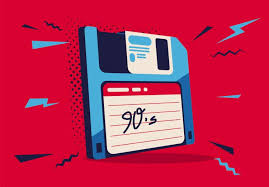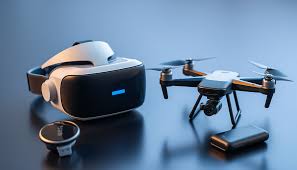The Enduring Charm of Old Technology
In today’s fast-paced world of ever-evolving technology, it’s easy to get caught up in the excitement of the latest gadgets and innovations. However, amidst the constant stream of new releases and updates, there is a certain charm and nostalgia associated with old technology that continues to captivate us.
Old technology, whether it be a vintage camera, a classic vinyl record player, or a trusty typewriter, holds a special place in our hearts for several reasons. One of the most significant appeals of old technology is its simplicity. In a time when devices are becoming increasingly complex and interconnected, there is something refreshing about the straightforward functionality of older gadgets.
Moreover, old technology often carries with it a sense of history and tradition. Each scratch on a well-loved vinyl record or each click of a mechanical keyboard tells a story of its own, connecting us to the past in a way that modern devices simply cannot replicate.
Another aspect that makes old technology so endearing is its durability. Unlike many of today’s disposable electronics, vintage devices were built to last. Their robust construction and timeless design make them not only functional but also aesthetically pleasing additions to any collection.
Furthermore, using old technology can be a form of escapism from the constant barrage of notifications and digital noise that characterise our daily lives. There is something meditative about winding the film in an analogue camera or hearing the satisfying clack-clack sound of a retro typewriter as you type away.
While it’s true that old technology may lack some of the advanced features and conveniences we have come to expect from modern devices, its enduring appeal lies in its ability to evoke feelings of nostalgia, simplicity, and authenticity. So next time you come across an antique radio or dusty VHS player tucked away in your attic, take a moment to appreciate the beauty and charm of these relics from another era.
Timeless Advantages: Celebrating the Merits of Old Technology
- 1. Simplicity in design and functionality
- 2. Durability and longevity of materials
- 3. Nostalgic value that evokes fond memories
- 4. Connection to history and tradition
- 5. Aesthetic appeal of vintage designs
- 6. Escape from digital distractions and constant connectivity
- 7. Tangible user experience with physical controls and mechanisms
- 8. Sustainable option compared to disposable modern electronics
- 9. Unique character and personality in each piece
Seven Drawbacks of Outdated Technology
- Limited functionality compared to modern devices
- Lack of compatibility with current software and hardware
- Difficulty in finding replacement parts or repair services
- Higher energy consumption and inefficiency
- Bulkier and heavier designs that are less portable
- Risk of obsolescence and inability to keep up with evolving technology trends
- Limited connectivity options for sharing data or accessing online resources
1. Simplicity in design and functionality
Old technology stands out for its simplicity in design and functionality, offering a refreshing contrast to the complexity of modern devices. Whether it’s the straightforward mechanics of a vintage camera or the intuitive controls of a classic record player, old technology excels in providing users with a user-friendly experience that is both easy to understand and operate. This simplicity not only enhances usability but also fosters a sense of nostalgia and appreciation for a time when gadgets were designed with elegance and efficiency in mind.
2. Durability and longevity of materials
One notable advantage of old technology is the exceptional durability and longevity of materials used in its construction. Unlike many modern devices that are designed with planned obsolescence in mind, vintage technology was built to withstand the test of time. From sturdy metal casings to robust mechanical components, old gadgets were crafted with quality materials that ensured their longevity, making them reliable companions that could last for generations. The emphasis on durability not only reduced the need for frequent replacements but also contributed to a more sustainable approach to consumer electronics.
3. Nostalgic value that evokes fond memories
One of the most compelling aspects of old technology is its nostalgic value, which has the power to evoke fond memories of simpler times gone by. Whether it’s the crackling sound of a vinyl record playing on a vintage turntable or the familiar click-clack of a manual typewriter, interacting with old technology can transport us back to cherished moments from our past. The nostalgia associated with these devices not only brings a sense of comfort and familiarity but also serves as a reminder of how far we’ve come in the realm of technological advancement.
4. Connection to history and tradition
One of the compelling advantages of old technology is its ability to establish a profound connection to history and tradition. Each vintage device carries with it a rich narrative of the past, allowing users to immerse themselves in the bygone eras in which these technologies thrived. By interacting with old technology, whether it’s a classic film camera or a retro gaming console, individuals can appreciate the evolution of innovation over time and gain a deeper understanding of how technological advancements have shaped society. This connection to history and tradition not only fosters nostalgia but also instils a sense of appreciation for the ingenuity and craftsmanship of earlier generations.
5. Aesthetic appeal of vintage designs
The aesthetic appeal of vintage designs is a charming pro of old technology that continues to captivate enthusiasts and collectors alike. From the sleek lines of mid-century radios to the intricate details of retro cameras, vintage devices often boast a timeless elegance and craftsmanship that are hard to replicate in modern gadgets. The nostalgia-inducing design elements of old technology not only serve as a visual treat but also offer a glimpse into the artistic sensibilities and trends of bygone eras, adding a touch of sophistication and character to any collection or space they adorn.
6. Escape from digital distractions and constant connectivity
One of the significant advantages of old technology is its ability to provide an escape from the digital distractions and constant connectivity that define our modern world. By embracing vintage gadgets like analogue cameras or retro typewriters, individuals can disconnect from the online noise and immerse themselves in a more focused and mindful experience. The simplicity and tactile nature of old technology offer a refreshing break from the constant notifications and screen time that often overwhelm us, allowing for a more peaceful and undistracted creative process.
7. Tangible user experience with physical controls and mechanisms
One of the notable advantages of old technology is the tangible user experience it offers through physical controls and mechanisms. Unlike many modern devices that rely heavily on touchscreens and virtual interfaces, old technology provides users with a hands-on interaction that engages multiple senses. The tactile feedback of pressing buttons, turning dials, or adjusting levers not only enhances the user experience but also creates a more intuitive and satisfying way to interact with the device. This physical engagement can foster a deeper connection between the user and the technology, adding a sense of craftsmanship and authenticity to the overall interaction.
8. Sustainable option compared to disposable modern electronics
One significant advantage of old technology is its sustainability compared to disposable modern electronics. Vintage devices were often built with durable materials and designed to withstand the test of time, making them a more environmentally friendly option. Unlike today’s fast-paced consumer culture that encourages frequent upgrades and discarding of electronic devices, old technology promotes a mindset of longevity and reuse, contributing to a more sustainable approach to technology consumption. By embracing and utilising old technology, we not only reduce electronic waste but also appreciate the craftsmanship and value inherent in these timeless pieces of innovation.
9. Unique character and personality in each piece
One of the standout advantages of old technology is the unique character and personality imbued in each piece. Unlike mass-produced modern devices, vintage technology often bears the marks of individual craftsmanship and design, giving each item its own distinct charm. Whether it’s the weathered patina of an old camera or the elegant curves of a retro radio, these artefacts carry a sense of history and story that adds a special allure to their functionality. Embracing old technology allows us to appreciate the beauty of imperfections and quirks that make each piece truly one-of-a-kind.
Limited functionality compared to modern devices
One significant drawback of old technology is its limited functionality when compared to modern devices. Vintage gadgets and tools often lack the advanced features and capabilities that we have come to rely on in today’s digital age. Whether it’s the limited storage capacity of old computers, the basic functions of traditional cameras, or the slow processing speeds of vintage electronics, using outdated technology can sometimes feel restrictive and inefficient. As we embrace the convenience and versatility offered by modern devices, it becomes apparent that old technology falls short in meeting the demands of our increasingly connected and fast-paced world.
Lack of compatibility with current software and hardware
One significant drawback of old technology is its lack of compatibility with current software and hardware. As technology advances rapidly, older devices and systems often struggle to keep up with the latest updates and requirements. This can lead to issues such as incompatibility with modern software programs, limited connectivity options, and difficulty in transferring data between old and new devices. The inability of old technology to seamlessly integrate with the current digital ecosystem can pose challenges for users who rely on interoperability for efficient workflow and communication.
Difficulty in finding replacement parts or repair services
One significant drawback of old technology is the challenge of sourcing replacement parts or repair services. As devices age and manufacturers discontinue production, tracking down specific components or skilled technicians capable of repairing vintage gadgets can become a frustrating and time-consuming task. This difficulty in finding adequate support can often render beloved old technology unusable, leaving enthusiasts with no choice but to either adapt to the limitations or reluctantly retire their cherished devices.
Higher energy consumption and inefficiency
One significant drawback of old technology is its higher energy consumption and inefficiency compared to modern devices. Vintage gadgets and appliances often require more power to operate, leading to increased electricity bills and a larger carbon footprint. The inefficiency of older technology not only contributes to environmental concerns but also results in higher maintenance costs and decreased overall performance. As we strive towards sustainability and energy efficiency in today’s world, the energy-intensive nature of old technology stands out as a notable disadvantage that cannot be overlooked.
Bulkier and heavier designs that are less portable
One notable drawback of old technology is its bulkier and heavier designs, which often make them less portable compared to their modern counterparts. Vintage devices such as old televisions, bulky desktop computers, and classic game consoles were built with sturdy materials that prioritised durability over portability. Carrying around these heavy gadgets can be cumbersome and impractical, especially in today’s world where sleek and lightweight devices are the norm. The lack of portability in old technology can limit their usability in a mobile-centric society where convenience and on-the-go functionality are highly valued.
Risk of obsolescence and inability to keep up with evolving technology trends
One significant drawback of old technology is the risk of obsolescence and the inability to keep up with evolving technology trends. As newer and more advanced innovations continue to emerge at a rapid pace, older devices may struggle to remain relevant and compatible with modern systems. This can lead to difficulties in finding support, updates, or replacement parts for outdated technology, ultimately limiting its usability and functionality in an increasingly digital world. The constant march of progress can render once-beloved gadgets obsolete, highlighting the challenge of maintaining pace with ever-changing technological landscapes when relying on older equipment.
Limited connectivity options for sharing data or accessing online resources
One significant drawback of old technology is its limited connectivity options, which hinder the seamless sharing of data and accessing online resources that we often take for granted today. Unlike modern devices that are equipped with high-speed internet connectivity, Bluetooth capabilities, and cloud storage integration, older gadgets may rely on outdated ports or physical media for data transfer. This limitation not only makes it challenging to collaborate with others in real-time but also restricts the ability to access a wealth of online resources and services that have become essential in our interconnected world.




